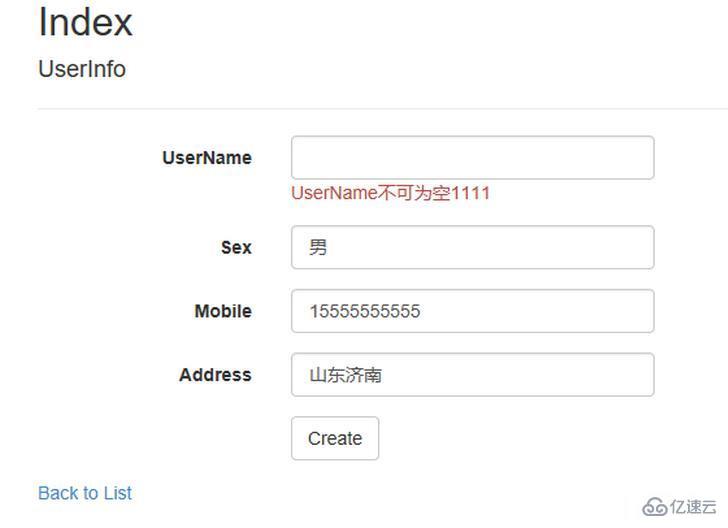这篇文章主要介绍如何对MVC进行数据验证,文中介绍的非常详细,具有一定的参考价值,感兴趣的小伙伴们一定要看完!
一、一般情况
对于使用过MVC框架的人来说,对MVC的数据验证不会陌生,比如,我有一个Model如下:
public class UserInfo
{
[Required(ErrorMessage = "UserName不可为空1111")]
public string UserName { get; set; }
public string Sex { get; set; }
public string Mobile { get; set; }
public string Address { get; set; }
}前端:
@using (Html.BeginForm())
{
@Html.AntiForgeryToken()
<p class="form-horizontal">
<h5>UserInfo</h5>
<hr />
@Html.ValidationSummary(true, "", new { @class = "text-danger" })
<p class="form-group">
@Html.LabelFor(model => model.UserName, htmlAttributes: new { @class = "control-label col-md-2" })
<p class="col-md-10">
@Html.EditorFor(model => model.UserName, new { htmlAttributes = new { @class = "form-control" } })
@Html.ValidationMessageFor(model => model.UserName, "", new { @class = "text-danger" })
</p>
</p>
<p class="form-group">
@Html.LabelFor(model => model.Sex, htmlAttributes: new { @class = "control-label col-md-2" })
<p class="col-md-10">
@Html.EditorFor(model => model.Sex, new { htmlAttributes = new { @class = "form-control" } })
@Html.ValidationMessageFor(model => model.Sex, "", new { @class = "text-danger" })
</p>
</p>
<p class="form-group">
@Html.LabelFor(model => model.Mobile, htmlAttributes: new { @class = "control-label col-md-2" })
<p class="col-md-10">
@Html.EditorFor(model => model.Mobile, new { htmlAttributes = new { @class = "form-control" } })
@Html.ValidationMessageFor(model => model.Mobile, "", new { @class = "text-danger" })
</p>
</p>
<p class="form-group">
@Html.LabelFor(model => model.Address, htmlAttributes: new { @class = "control-label col-md-2" })
<p class="col-md-10">
@Html.EditorFor(model => model.Address, new { htmlAttributes = new { @class = "form-control" } })
@Html.ValidationMessageFor(model => model.Address, "", new { @class = "text-danger" })
</p>
</p>
<p class="form-group">
<p class="col-md-offset-2 col-md-10">
<input type="submit" value="Create" class="btn btn-default" />
</p>
</p>
</p>
}效果:

是的,MVC可以通过对一些属性添加一定的特性来对数据进行验证。这对大家来说可能并不陌生。
如果仅仅是这样就完事了,那么也就没事么意思了。
二、常用情况
在实际的开发中,我们大都是通过EF,或者其他方式,使得数据库中的每一个表或视图,都在代码中对应的一个类模型,对于通过数据库生成的模型,我们不宜修改,退一步讲,即使我们在这个类中对一些属性增加一些数据验证的特性,那么,数据库发生变化后,如果我再重新生成这些Model,我们之前添加好的验证特性将没有了,那么,我们如何解决这样的问题呢?
假如:
public class UserInfo
{
public string UserName { get; set; }
public string Sex { get; set; }
public string Mobile { get; set; }
public string Address { get; set; }
}UserInfo是通过数据库生成的一个模型,对于数据库生成的模型,我们不宜修改。但那是,我们又需要对这个模型中的某些属性进行数据验证,比如需要对UserName属性进行非空验证,那么我们如何做呢?
大家通常会想到部分类,是的,我们可以通过部分类来解决上述问题。
首先,我们将模型中的类加上关键字 partial ,然后我们再写一个这个模型的部分类。
public partial class UserInfo
{
[Required(ErrorMessage = "UserName不可为空1111")]
public string UserName { get; set; }
}但是,这样会提示我们一个错误,就是类中存在重复的属性,是的,部分类中,属性是不可以重名的。那么,我们该怎么办呢,MVC框架已经给了我们解决方案了。
我们可以这么写:
[MetadataType(typeof(MeteUserInfo))]
public partial class UserInfo
{
private class MeteUserInfo
{
[Required(ErrorMessage = "UserName不可为空1111")]
public string UserName { get; set; }
}
}以上是“如何对MVC进行数据验证”这篇文章的所有内容,感谢各位的阅读!希望分享的内容对大家有帮助,更多相关知识,欢迎关注亿速云行业资讯频道!
亿速云「云服务器」,即开即用、新一代英特尔至强铂金CPU、三副本存储NVMe SSD云盘,价格低至29元/月。点击查看>>
免责声明:本站发布的内容(图片、视频和文字)以原创、转载和分享为主,文章观点不代表本网站立场,如果涉及侵权请联系站长邮箱:is@yisu.com进行举报,并提供相关证据,一经查实,将立刻删除涉嫌侵权内容。